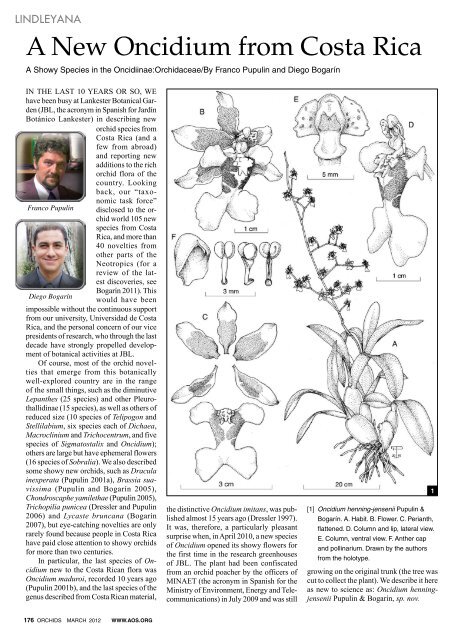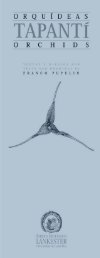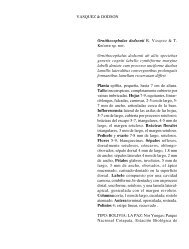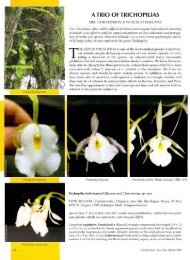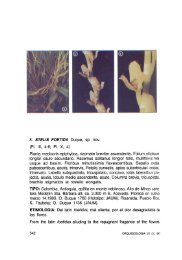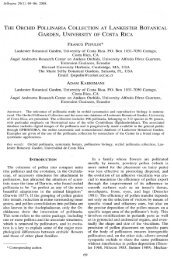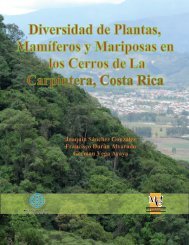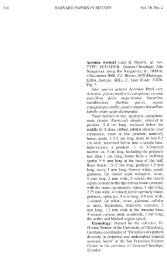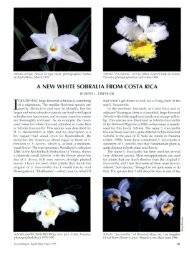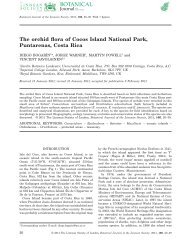A New Oncidium from Costa Rica - Epidendra.org
A New Oncidium from Costa Rica - Epidendra.org
A New Oncidium from Costa Rica - Epidendra.org
You also want an ePaper? Increase the reach of your titles
YUMPU automatically turns print PDFs into web optimized ePapers that Google loves.
lindleyana<br />
A <strong>New</strong> <strong>Oncidium</strong> <strong>from</strong> <strong>Costa</strong> <strong>Rica</strong><br />
A Showy Species in the Oncidiinae:Orchidaceae/By Franco Pupulin and Diego Bogarín<br />
In the last 10 years or so, we<br />
have been busy at lankester Botanical Garden<br />
(JBl, the acronym in spanish for Jardín<br />
Botánico lankester) in describing new<br />
orchid species <strong>from</strong><br />
<strong>Costa</strong> rica (and a<br />
few <strong>from</strong> abroad)<br />
and reporting new<br />
additions to the rich<br />
orchid flora of the<br />
country. looking<br />
back, our “taxo-<br />
Franco Pupulin<br />
Diego Bogarín<br />
nomic task force”<br />
disclosed to the orchid<br />
world 105 new<br />
species <strong>from</strong> <strong>Costa</strong><br />
rica, and more than<br />
40 novelties <strong>from</strong><br />
other parts of the<br />
neotropics (for a<br />
review of the latest<br />
discoveries, see<br />
Bogarín 2011). this<br />
would have been<br />
impossible without the continuous support<br />
<strong>from</strong> our university, Universidad de <strong>Costa</strong><br />
rica, and the personal concern of our vice<br />
presidents of research, who through the last<br />
decade have strongly propelled development<br />
of botanical activities at JBl.<br />
of course, most of the orchid novelties<br />
that emerge <strong>from</strong> this botanically<br />
well-explored country are in the range<br />
of the small things, such as the diminutive<br />
Lepanthes (25 species) and other Pleurothallidinae<br />
(15 species), as well as others of<br />
reduced size (10 species of Telipogon and<br />
Stellilabium, six species each of Dichaea,<br />
Macroclinium and Trichocentrum, and five<br />
species of Sigmatostalix and <strong>Oncidium</strong>);<br />
others are large but have ephemeral flowers<br />
(16 species of Sobralia). we also described<br />
some showy new orchids, such as Dracula<br />
inexperata (Pupulin 2001a), Brassia suavissima<br />
(Pupulin and Bogarín 2005),<br />
Chondroscaphe yamilethae (Pupulin 2005),<br />
Trichopilia punicea (Dressler and Pupulin<br />
2006) and Lycaste bruncana (Bogarín<br />
2007), but eye-catching novelties are only<br />
rarely found because people in <strong>Costa</strong> rica<br />
have paid close attention to showy orchids<br />
for more than two centuries.<br />
In particular, the last species of <strong>Oncidium</strong><br />
new to the <strong>Costa</strong> rican flora was<br />
<strong>Oncidium</strong> maduroi, recorded 10 years ago<br />
(Pupulin 2001b), and the last species of the<br />
genus described <strong>from</strong> <strong>Costa</strong> rican material,<br />
176 OrchiDS mArch 2012 www.AOS.Org<br />
the distinctive <strong>Oncidium</strong> imitans, was published<br />
almost 15 years ago (Dressler 1997).<br />
It was, therefore, a particularly pleasant<br />
surprise when, in april 2010, a new species<br />
of <strong>Oncidium</strong> opened its showy flowers for<br />
the first time in the research greenhouses<br />
of JBl. the plant had been confiscated<br />
<strong>from</strong> an orchid poacher by the officers of<br />
MInaet (the acronym in spanish for the<br />
Ministry of environment, energy and telecommunications)<br />
in July 2009 and was still<br />
[1] <strong>Oncidium</strong> henning-jensenii Pupulin &<br />
Bogarín. A. habit. B. Flower. c. Perianth,<br />
flattened. D. column and lip, lateral view.<br />
E. column, ventral view. F. Anther cap<br />
and pollinarium. Drawn by the authors<br />
<strong>from</strong> the holotype.<br />
growing on the original trunk (the tree was<br />
cut to collect the plant). we describe it here<br />
as new to science as: <strong>Oncidium</strong> henningjensenii<br />
Pupulin & Bogarín, sp. nov.<br />
1
F. PUPUPLin<br />
TYPE Presumably <strong>Costa</strong> rica. Puntarenas-san<br />
José: Zona sur, without<br />
further locality data, a plant confiscated<br />
by MInaet officers along the southern<br />
Pan-american highway in the Cerro de<br />
la Muerte region. Flowered in cultivation<br />
at lankester Botanical Garden, University<br />
of <strong>Costa</strong> rica, april 27, 2010, JBL-21878<br />
(holotype, Cr; isotype, JBl-spirit).<br />
species oncidio ansifero rchb.f. et<br />
oncidio stenoglosso Kraenzl. pseudobulbis<br />
similis, sed habito repente floribus<br />
multo majoribus luteis sepalis subbrunneis<br />
maculatis (vs. atrobrunneum vel brunneum<br />
punctatum maculatum) et labello magis lato<br />
inter lobulos laterales; ab oncidio ansifero<br />
praeterea recedit lobulis lateralibus labelli<br />
subflabelliformi-transverse ellipticis et ab<br />
oncidiio stenobulbo isthmo labelli multo<br />
latiore et alis columnae magnis dolabriformis<br />
praecipue distinctum est.<br />
epiphytic, caespitose, repent herb to<br />
60 cm tall. roots slender, flexuous, 1.1–1.3<br />
mm in diameter. rhizome elongate, repentascending,<br />
8–10 mm thick, producing roots<br />
<strong>from</strong> internodes, the pseudobulbs 4.0–5.2<br />
cm apart. Pseudobulbs ovate-elliptic,<br />
smooth, green with yellowish margins,<br />
homoblastic, with two to three internodes,<br />
strongly ancipitous and flattened, subtended<br />
at the base by one to two foliaceous<br />
sheaths, elliptic, acute, conduplicate, different<br />
in size, the larger 17.0–22.0 × 7.0–8.0<br />
cOUrTESY OF ThE vicE-PrESiDEncY OF rESEArch, UnivErSiTY OF cOSTA ricA<br />
cm, the smaller 10.0–14.0 × 4.5–6.5 cm,<br />
the margins hyaline, articulate with the<br />
sheath, often becoming dry-papyraceous<br />
with age; the basal node 12.0–15.0 ×<br />
6.0–9.0 cm, the second node obovate,<br />
2.2–2.5 × 2.2–2.5 cm, the third node (when<br />
present) subreniform, 0.7–0.9 × 1.0–1.2<br />
cm. leaves two to three, narrowly elliptic<br />
to lanceolate, conduplicate-subpetiolate,<br />
smaller toward the apex of the pseudobulb,<br />
13.5–30.0 × 4.0–8.5 cm, constricted<br />
into a conduplicate petiole up to 2.5 cm<br />
long. Inflorescence basal, one to two per<br />
F. PUPUPLin<br />
3 4<br />
[2] <strong>Oncidium</strong> henning-jensenii, a detail of the<br />
inflorescence <strong>from</strong> the plant that served<br />
as the holotype. The flowers of the new<br />
species are among the largest in costa<br />
rica.<br />
[3] Don henning, for whom Onc. henningjensenii<br />
is named.<br />
[4] <strong>Oncidium</strong> henning-jensenii, flower <strong>from</strong><br />
the plant (holotype) flowered in cultivation<br />
at Lankester Botanical Garden, University<br />
of costa rica, and photographed in<br />
April 2010.<br />
www.AOS.Org mArch 2012 OrchiDS 177<br />
2
lindleyana<br />
growth, a branched raceme, simultaneously<br />
many-flowered (to 30+) to 80 cm long, the<br />
peduncle terete, erect, to 15 cm long, with<br />
two to three triangular, acute-acuminate,<br />
brown, adpressed bracts 2 cm long; lateral<br />
branches horizontal-ascending, slightly<br />
fractiflex, progressively shorter toward the<br />
apex, three- to six-flowered, 7.5–15.0 cm<br />
long. Floral bracts glumaceous, broadly<br />
triangular-ovate, 5–9 × 4–7 mm. ovary<br />
pedicellate, terete, narrowing toward the<br />
apex, 5.5–7.0 cm long. Flowers spreading,<br />
yellow with chestnut maculations, sepals<br />
and petals yellow, basally pale brown with<br />
a yellow margin, reflexed, the lip yellow,<br />
the callus yellow marked with chestnut,<br />
the apex of the teeth white, the isthmus<br />
yellow with a brown blotch, the column yellow,<br />
sparsely spotted with chestnut on the<br />
wings. sepals subsimilar, shortly clawed,<br />
lanceolate-elliptic, acute, keeled dorsally,<br />
the apices abaxially shortly mucronate-reflexed,<br />
the margins undulate-wavy, marked<br />
with brown in the basal two thirds, 1.6–2.0<br />
× 0.5–0.6 cm. Petals unguiculate, elliptic,<br />
178 OrchiDS mArch 2012 www.AOS.Org<br />
[5] comparison of the dissected perianths<br />
of: A. Onc. ansiferum, B. Onc. stenobulbon<br />
and c. Onc. henning-jensenii.<br />
illustration vouchers: A. Bogarín 5500;<br />
B. Pupulin 303; c. JBL-21878.<br />
[6] comparison of the flowers of: A. Onc. ansiferum,<br />
B. Onc. stenobulbon and c. Onc.<br />
henning-jensenii. vouchers: A. Pupulin<br />
2663; B. Pupulin 7001; c. JBL-21878.<br />
acute, slightly reflexed, the margins weakly<br />
undulate, 1.7–1.9 × 0.8–0.9 cm, blotched in<br />
the basal two thirds, the claw longitudinally<br />
reflexed. lip trilobed, up to 2.5 cm across<br />
the lateral lobes, the basal lobes transversely<br />
subflabelliform-elliptic, 0.9 × 0.7 mm,<br />
the isthmus subrectangular-cuneate, the<br />
margins reflexed, 11 × 9 mm, the midlobe<br />
deeply emarginate-bilobed, transversely<br />
subrectangular in outline, 1.1 × 2.1 cm, each<br />
lobe obliquely broadly elliptic-rounded, the<br />
margins undulate; disc with a multidigitate<br />
callus, composed of two parallel series of<br />
two teeth on each side, and three apical teeth,<br />
5<br />
6<br />
DrAwn BY ThE AUThOrS<br />
PhOTOGrAPhS BY ThE AUThOrS<br />
the central one slightly longer; entire callus<br />
7.0 × 6.0 mm. Column subterete, 0.9–1.0 cm,<br />
provided with a transversely elliptic, channeled<br />
tabula infrastigmatica and two large,<br />
subapical, dolabriform, erose-denticulate<br />
wings 3 × 5 mm, the stigma transversely<br />
subrectangular, ventral, the anther incumbent.<br />
anther cap elliptic, deeply cucullate,<br />
two-celled. Pollinia two, subglobose, cleft,<br />
on a narrow tubularized stipe with an apical<br />
saddle on which the pollinia are attached,<br />
viscidium oblong.<br />
DiSTriBUTiOn Known only <strong>from</strong><br />
the type specimen and likely endemic to<br />
<strong>Costa</strong> rica.<br />
hABiTAT AnD EcOLOGY Unknown.<br />
the single plant (also the holotype)<br />
was not associated with specific locality<br />
data. as the plant was confiscated by the<br />
officers of MInaet along the southern<br />
Pan-american highway in the vicinity<br />
of the Cerro de la Muerte, we argue that it<br />
was likely collected in the region of Dota<br />
or Pérez Zeledón, on the Pacific watershed<br />
of the talamanca mountain range in central<br />
<strong>Costa</strong> rica. Presumably the plant was collected<br />
in a humid warm area shortly before<br />
it was confiscated because it was brought<br />
attached to a trunk covered by mosses together<br />
with several plants of Trichocentrum<br />
ascendens (lindl.) M.w. Chase & n.h.<br />
williams; the latter is known <strong>from</strong> lower<br />
elevations (up to ca. 1,000 m or 3,280 feet)<br />
on the Pacific side of <strong>Costa</strong> rica. two other<br />
species of <strong>Oncidium</strong> with strongly flattened,<br />
ancipitous pseudobulbs have been recorded<br />
<strong>from</strong> <strong>Costa</strong> rica: <strong>Oncidium</strong> ansiferum<br />
rchb.f. and <strong>Oncidium</strong> stenobulbon Kraenzl.<br />
they are known locally as “caite” (sandal)<br />
and “galleta,” (cookie), respectively,<br />
in allusion to the unusual flatness of the<br />
pseudobulbs in both species. <strong>Oncidium</strong><br />
ansiferum mostly grows in wet forests at<br />
elevations of 1,300–2,200 m (4,260–7,220<br />
feet), whereas Onc.stenobulbon is found at<br />
lower elevations in seasonal forest along<br />
the Pacific coast at elevations of 0–1,000<br />
m (0–3,280 feet).<br />
EPOnYmY Dedicated to henning<br />
Jensen Pennington, former vice president<br />
of research, University of <strong>Costa</strong> rica, in<br />
recognition of the strong support he gave<br />
to the development of lankester Botanical<br />
Garden and the research activities carried<br />
out at our Center.<br />
PhEnOLOGY the plant flowered<br />
between april and May under greenhouse<br />
conditions.<br />
DiScUSSiOn <strong>Oncidium</strong> henningjensenii<br />
is morphologically similar to Onc.<br />
ansiferum and Onc. stenobulbon. the three<br />
species are easily recognized by their flat,<br />
strongly flattened, ancipitous pseudobulbs,
Table 1: comparison of characteristics of the different taxa.<br />
Character Onc. ansiferum Onc. stenobulbon Onc. henning-jensenii<br />
Color of sepals Blotched dark Spotted pale Blotched pale<br />
and petals brown brown brown<br />
Petals 15 × 7 mm 13 × 5 mm 17 × 9 mm<br />
Lateral lobes Oblong, Transversely Subflabelliform-<br />
of lip 4 × 3 mm elliptic, 4 × 4 mm transversely elliptic,<br />
9 × 7 mm<br />
Isthmus 5 × 4 mm 6 × 3 mm 11 × 9 mm<br />
Across basal lobes<br />
of lip<br />
12 mm 15 mm 25 mm<br />
Callus 5 × 4 mm 5 × 3 mm 7 × 6 mm<br />
Midlobe in natural<br />
position<br />
Superposed Superposed Spread, flat<br />
Column wings 2 × 4 mm 1 × 2 mm 3 × 5 mm<br />
the long, paniculate, many-flowered inflorescences<br />
and the flowers yellow, spotted<br />
or stained with red-brown. among its<br />
relatives, Onc. henning-jensenii differs<br />
in its yellow sepals and petals with pale<br />
brown blotches at base (vs. dark brown in<br />
Onc. ansiferum and with spotted sepals and<br />
petals in Onc. stenobulbon) and the larger<br />
floral segments, with the lip up to 2 cm long<br />
(vs. up to 1.3 cm) (see table 1). the basal<br />
lobes of its lip are wider and larger, and<br />
the midlobe is retuse without superposed<br />
lobes at apex. <strong>Oncidium</strong> ansiferum is unmistakable<br />
with its dark brown, blotched<br />
sepals and petals with yellow apex, and its<br />
lip is distinctly broader across the midlobe<br />
than across the small, oblong basal lobes.<br />
<strong>Oncidium</strong> stenobulbon is also similar but<br />
has small column wings, a much narrower<br />
isthmus and smaller floral parts.<br />
references<br />
Bogarín, D. 2011. how Many orchid species in <strong>Costa</strong><br />
rica? a review of the latest Discoveries. p. 185–205<br />
in: a.M. Pridgeon and h.G. navarrete Zambrano, editors.<br />
Proceedings of the Third Scientific Conference of<br />
Andean Orchids, Quito, Ecuador. Lankesteriana 11.<br />
_. 2007. a new Lycaste (orchidaceae: Maxillarieae) <strong>from</strong><br />
<strong>Costa</strong> rica. Lankesteriana 7:543–549.<br />
Dressler, r.l. 1997. new species and Combinations in<br />
<strong>Costa</strong> rican orchids. Novon 7:120–126.<br />
Dressler, r.l., and F. Pupulin. 2006. the Carmine trichopilias<br />
of Central america: Few, but Badly Confused.<br />
Lindleyana in Orchids 75:212–220.<br />
Pupulin, F. 2001a. extending the range: a south american<br />
Dracula in <strong>Costa</strong> rica. Orchids 80:564–567.<br />
_. 2001b. Presence of the orchid <strong>Oncidium</strong> maduroi (orchidaceae:oncidiinae)<br />
in <strong>Costa</strong> rica. Revista Biologia<br />
Tropical 49:1261–1262.<br />
_. 2005. Vanishing Beauty. Native <strong>Costa</strong> <strong>Rica</strong>n Orchids,<br />
vol. 1: Acianthera-Kegeliella. editorial de la Universidad<br />
de <strong>Costa</strong> rica, san José.<br />
Pupulin, F., and D. Bogarín. 2005. the Genus Brassia in<br />
<strong>Costa</strong> rica: a survey of Four species and a new species.<br />
Lindleyana in Orchids 74:202–207.<br />
Acknowledgments<br />
we thank the scientific services of Ministerio<br />
del ambiente, energía y telecomunicaciones de<br />
<strong>Costa</strong> rica (MInaet) and sistema nacional de<br />
Áreas de Conservación (sInaC) for issuing the<br />
scientific passports under which this research<br />
was conducted and for bringing to JBl the plant<br />
confiscated. the review by M.w. Chase and his<br />
accurate observations greatly improved the manuscript.<br />
this paper is part of the Project 814-a7-015,<br />
“Inventario y taxonomía de la flora epífita de la<br />
región neotropical — orchidaceae,” sponsored<br />
by the vice-presidency of research, University of<br />
<strong>Costa</strong> rica.<br />
Franco Pupulin is a senior research professor<br />
at the University of <strong>Costa</strong> <strong>Rica</strong>, where<br />
he works as director of research with Lankester<br />
Botanical Garden. He is especially<br />
Interested in the systematics and evolution<br />
of advanced orchid groups in subtribes<br />
Oncidiinae, Pleurothallidinae and Zygopetalinae.<br />
Pupulin is working on several<br />
monographic and floristic projects on Neotropical<br />
orchid floras. Author of more than<br />
170 scientific articles and several books on<br />
the orchids of the Mesoamerican region, he<br />
is a research associate of the Oakes Ames<br />
Orchid Herbarium at Harvard University<br />
and the Marie Selby Botanical Gardens,<br />
Sarasota, Florida, and the director of<br />
the Ángel Andreetta Research Center on<br />
Andean Orchids of the University Alfredo<br />
Pérez Guerrero, Ecuador. (email franco.<br />
pupulin@ucr.ac.cr).<br />
Diego Bogarín is interested in the<br />
evolution and systematics of Neotropical<br />
Orchidaceae. He is developing floristic<br />
projects for conservation in <strong>Costa</strong> <strong>Rica</strong> and<br />
Panama and has participated in projects<br />
on DNA barcoding and orchid conservation<br />
with the Royal Botanic Gardens, Kew.<br />
He is an orchid taxonomist at Lankester<br />
Botanical Garden and research associate<br />
of the Ańgel Andreetta Research Center on<br />
Andean Orchids of the University Alfredo<br />
Pérez Guerrero, Ecuador. Bogarín has<br />
published a number of scientific papers on<br />
the orchid flora of <strong>Costa</strong> <strong>Rica</strong> and other<br />
Neotropical regions. (email diego.bogarin@ucr.ac.cr).<br />
www.AOS.Org mArch 2012 OrchiDS 179


